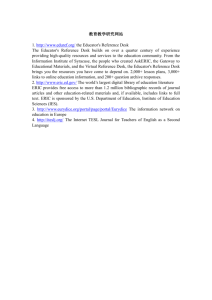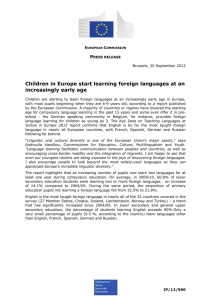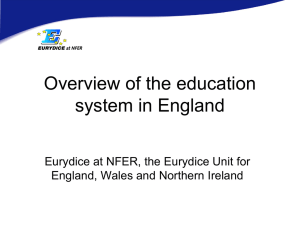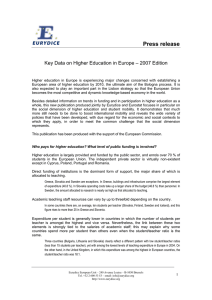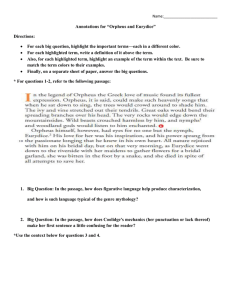Europe’s Private and Public Higher Education Shares (2002-2009)
advertisement
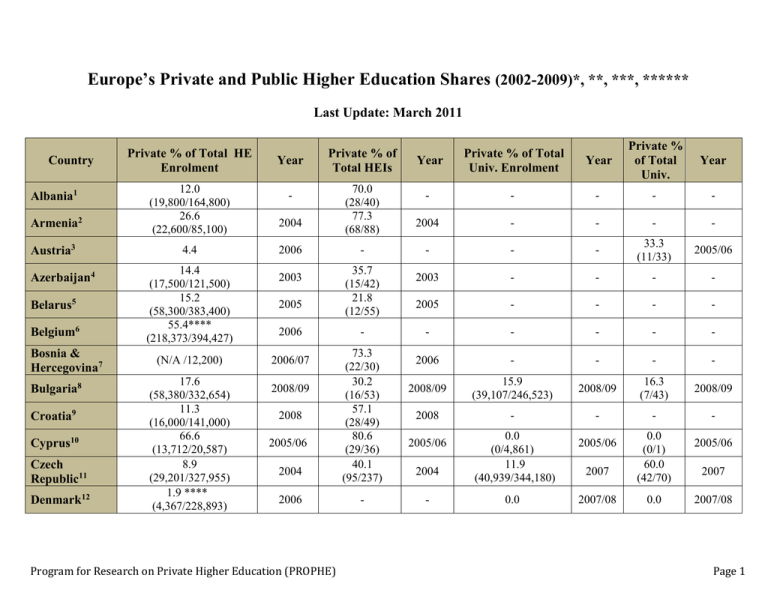
Europe’s Private and Public Higher Education Shares (2002-2009)*, **, ***, ****** Last Update: March 2011 Country Albania1 Armenia2 Austria3 Azerbaijan4 Belarus5 Belgium6 Bosnia & Hercegovina7 Bulgaria8 Croatia9 Cyprus10 Czech Republic11 Denmark12 Private % of Total HE Enrolment 12.0 (19,800/164,800) 26.6 (22,600/85,100) 4.4 14.4 (17,500/121,500) 15.2 (58,300/383,400) 55.4**** (218,373/394,427) (N/A /12,200) 17.6 (58,380/332,654) 11.3 (16,000/141,000) 66.6 (13,712/20,587) 8.9 (29,201/327,955) 1.9 **** (4,367/228,893) Year Private % of Total HEIs 2004 2006 2003 2005 2006 2006/07 2008/09 2008 2005/06 2004 2006 Program for Research on Private Higher Education (PROPHE) 70.0 (28/40) 77.3 (68/88) 35.7 (15/42) 21.8 (12/55) 73.3 (22/30) 30.2 (16/53) 57.1 (28/49) 80.6 (29/36) 40.1 (95/237) - Year Private % of Total Univ. Year - - - - 2004 - - - - - - - 33.3 (11/33) 2005/06 2003 - - - - 2005 - - - - - - - - - 2006 - - - - 2008/09 15.9 (39,107/246,523) 2008/09 16.3 (7/43) 2008/09 2008 - - - - Year Private % of Total Univ. Enrolment - 2005/06 2004 - 0.0 (0/4,861) 11.9 (40,939/344,180) 0.0 2005/06 2007 2007/08 0.0 (0/1) 60.0 (42/70) 0.0 2005/06 2007 2007/08 Page 1 Estonia13 Finland14 France15 Georgia16 Germany17 Greece18 18.0 (12,315/68,399) 10.5**** (32,393/308,966) 16.6 **** (364,783/2,201,201) 19.2 (29,400/153,300) 4.9 (94,285/1,920,102) 0.0 Iceland20 13.6 (56,590/416,348) 22.9 **** (3,853/16,853) Ireland21 7.0 Israel 22 13.1 (26,860/205,149) 7.2 (146,796/2,029,023) 50.7 (38,000/75,000) 31.9 (40,713/127,760) 8.5 (16,438/193,928) 17.9 (11,509/64,254) 20.0 (26,500/110,200) (N/A /20,000) Hungary19 Italy23 Kosovo24 Latvia25 Lithuania26 The FYR of Macedonia27 Moldova28 Montenegro29 2008/09 53.2 (24/46) 2004 - - 2006 0.0 2006 0.0 (0/176,555) 2006 2005/06 - - 2003 - - - - 2008/09 1.2 (15,760/1,339,274) 2008/09 23.9 (21/109) 2008/09 2005/06 0.0 2005/06 0.0 2005/06 2006/07 - - - - 2006/07 - - - - 2005/06 - - - - 2006 2003 2008/09 4.2 (147/3,500) 85.2 (150/176) 34.3 (122/356 ) 2005/06 2006/07 2005 2004 2005/06 2006 2007/08 2005/06 2007/08 2003 - Program for Research on Private Higher Education (PROPHE) 0.0 56.3 (40/71) 37.5 (3/8) 0.0 (0/20) 13.1 (8/61) 20.5 (17/83) 96.7 (32/33) 36.7 (22/60) 38.8 (19/49) 62.5 (5/8) 44.5 (48/108) 80.0 2005/06 2006/07 2007/08 2005/06 0.0 (0/123,010) 6.2 (110,624/1,780,743) 29.7 (34,172/114,965) 3.5 (4,992/141,771) 2005/06 2006/07 0.0 (0/20) 15.5 (13/84) 0.0 (0/7) 23.0 (17/74) 2006 2007/08 2005/06 2006/07 - - - 2007/08 - - 2005/06 33.3 (7/21) 2005/06 2004 - - - - 2003 - - - - - - - - - Page 2 (4/5) Netherlands30 Norway31 Poland32 Portugal 33 Romania34 Russia35 Serbia36 Slovak Republic37 Slovenia38 69.9 **** (361 177/516 769) 13.4 **** (28,434/211,559) 34.1 (660464/1,937,401) 25.9 (98,664/380,937) 33.8 (265,243/785,506) 14.9 (1,024,000/ 6,884,000) (N/A /239,000) 9.8 (20,098/ 204,082) 2.6 (3,552/136,990) 2002 2006/07 2007 2004/05 2007 2004 2006 2007/08 0.0 45.7 (32/70) 70.8 (315/445) 66.7 (110/165) 55.0 (37/67) 38.2 (409/1,071) 49.3 (33/67) 45.0 (9/20) 27.6 (8/29) 2006/07 2006/07 2005/06 2004/5 2003 1.0 (883/87,562) 3.7 (20,654/563,062) 27.9 (67,157/241,054) 23.1 (50,576/218,860) 2006/07 2005/06 2004/05 2005/06 8.3 (1/12) 25.0 (6/24) 69.2 (46/65) 49.0 (52/107) 2006/07 2005/06 2004/05 2005/06 2004 9.9 2000 37.1 2000 - - - - - 2006 - - - - 2007/8 - - - - 9.6**** 2001 30.0 2003 9.0 (132,000/1,463,000) 2004/05 7.3**** (30,476/414,657) 2003 40.0 (24/60) 2005 - - - - - - - - - - Turkey42 5.8 2005/06 2005/06 5.8 2005/06 26.1 (30/115) 2005/06 Ukraine43 12.0 (237,100/2,264,767) 0.0 (0/2,336,111) 2003 - - - - - - - 0.7 (1/139) 2006 Spain39 Sweden40 Switzerland41 United Kingdom44 2003 2006 Program for Research on Private Higher Education (PROPHE) 26.1 (30/115) 17.6 (175/997) - 32.4 (24/74) 17.6 (3/17) 2006/07 2006/07 Page 3 Total***** 16.0 (3,726,699/23,310,698) 25.7 (2,136/8,360) *Azerbaijan and Kazakhstan are listed in the Asia table, though they could also be listed in the Europe table. ** We use year 2002 in the title but as of now the only available data we could retrieve for Spain was in 2001. *** Caution: Although the data come from the most reliable sources we could find—usually official sources—criteria and inclusiveness both vary greatly across countries, so comparisons should be drawn only with caution. For example, the meaning of higher education, university, and tertiary education varies. In some databases, only accredited or at least licensed institutions are counted; in others, the figures are more broadly inclusive. There are also differences in how to count enrolments and in many other respects. Attention to such matters is keener in PROPHE’s in-depth data work on individual countries. See http://www.albany.edu/dept/eaps/prophe/data/national.html **** These countries include “government- dependent private institutions”. ”For several West European countries, there is great ambiguity on what is private. The OECD and Eurydice databases refer clearly enough to public institutions and to independent private institutions but also to government-dependent private institutions or, as with Eurydice on Iceland, “private parties with state support.” Although legally private, and administered by non-government agencies such as churches, businesses, trade unions, or other bodies, they are not normally seen as private within the country. Only the independent privates are. According to both databases, the difference between independent private institutions and governmentdependent private institutions lies in the degree of core funding a private institution gets from government. If an institution receives 50% or more of its core funding from the government, it is considered government-dependent; in turn, if an institution receives less than 50% of its core funding from the government, it is counted an independent private institution. In each case we put the inclusive private figure into the table and then give the independent private figure in the note to that country. PROPHE’s general preference is to list and count as private whatever is legally private and to count as public whatever is legally public—and then explore empirically what these institutions are like in practice. Additionally, many governmentdependent institutions are more autonomous (or “private”) in government than are public institutions, and, in any event, the 50% core funding mark is somewhat arbitrary. Still, in the interest of full information, we show separately both the total private figure (in the table) and the independent private share in those three **** countries that have, along with their government- dependent enrollment, independent private enrollment (in the notes in bold font). ***** If we sum all the enrolment data for Europe, we get a private share of 16.0%, excluding countries where either private enrolments or total enrolments are not available, such as Austria and Serbia. If we sum all the institutional data for Europe, we get a private share of 25.7 %, excluding countries where either private institutions or total institutions are not available, such as Austria and Belgium. Program for Research on Private Higher Education (PROPHE) Page 4 ****** The main preparers of this table are Daniel Levy, Prachayani Praphamontripong, Snejana Slantcheva, and Chunyue Zhang. Endnotes Bozo, Dhurata. (2009) “Balkan Region: The Turbo-Style Experience”: Albania. Paper presented at the OAR-NVAO Conference “Business as unusual-Private Higher Education in Europe: Fact-Finding, Experiences, Pathways,” Vienna, May 7-8, 2009, available at http://www.akkreditierungsrat.at/files/Seminar2009/Presentations_Vienna_7_8May2009/08_Bozo.pdf. 1 2 National Statistical Service of the Republic of Armenia at http://www.armstat.am/ and its annual statistical reports at: http://www.armstat.am/StatData/taregirq_05/taregirq_05_7.pdf; http://www.armstat.am/Publications/2004/soc_book/soc_book_3.pdf; http://www.armstat.am/Publications/2001/Armenia2001-eng/Armenia-3.pdf; http://www.armstat.am/Publications/2003/Armenia-2002/Armenia-02-III.3.1.3.pdf 3 Data on enrolments of higher education institutions from Austrian accreditation agency. . OECD also puts all private institutions as governmentdependent and puts that private enrolment share at 13.3% . Source: http://stats.oecd.org. But Eurydice notes there are 12 private universities http://eacea.ec.europa.eu/education/eurydice/eurybase_en.php; private universities were established following the 1999 University Accreditation Act and privately maintained educational institutions may be officially recognized as private universities by the state and acquire the right to confer academic degrees. 4 The State Statistical Committee of the Azerbaijan Republic (at http://www.azstat.org/); Statistical Yearbook of Azerbaijan 2004 at http://www.azstat.org/publications/yearbook/SYA2004/Pdf/08en.pdf Data from the General Information Analytical Centre for the Ministry of Education Republic of Belarus. “Higher Educational Institutions in Belarus” Statistical reference book, Minsk, 2005. 5 6 Belgian data from OECD Complete databases: http://stats.oecd.org. OECD reports that all private institutions are government-dependent. But see the endnote on the Netherlands regarding the traditional convention of seeing significant private enrolment. 7 See Bozo, note #1. 8 Data for 2008/9 from the National Statistical Institute of Bulgaria, available at http://www.nsi.bg/SocialActivities_e/Education_e.htm Program for Research on Private Higher Education (PROPHE) Page 5 9 See Bozo, note #1. 10 For the academic year 2005/06, the only university is the University of Cyprus. For academic year 2007/08 24 private institutions of tertiary education were registered with the Ministry of Education and Culture. By decision of the Council of Ministers in September 2007, the first three private universities were allowed to operate in October 2007. Eurydice: http://eacea.ec.europa.eu/education/eurydice/eurybase_en.php. 11 Czech Statistical Office. (2004) Statistical Yearbook of the Czech Republic 2003 (in the Czech language). Retrieved from http://www.czso.cz/csu/edicniplan.nsf/p/10n1-03 on March 23, 2006. Private university data is also from the Czech Statistical Office, 2007. http://www.czso.cz/csu/2008edicniplan.nsf/engkapitola/10n1-08-2008-2100 12 Danish Data from OECD Complete databases: http://stats.oecd.org. Here the private higher education institutions refer to government-dependent private institutions. On the other hand, Eurydice reports there are no private institutions as such at this level. Eurydice: http://eacea.ec.europa.eu/education/eurydice/eurybase_en.php and the European Accreditation Council reports that Denmark does not allow private higher education. 13 Statistical Office of Estonia, Statistical Database, available at http://www.stat.ee. Note: includes also private vocational education institutions that offer higher education. Data for 2008/09 from the Estonian Ministry of Education and Research, http://www.hm.ee. 14 Finnish data from OECD Complete databases: http://stats.oecd.org. OECD reports that all private institutions are government-dependent. On the other hand, Eurydice reports there are no private institutions at this level. It notes there are two sectors in tertiary education, universities and polytechnics (professionally-oriented), with all universities state-owned, but polytechnics either municipal or private and its higher education data here omits polytechnics. Eurydice: http://eacea.ec.europa.eu/education/eurydice/eurybase_en.php. Until the 1990s, the university system in Finland was synonymous with the higher education system. 15 Eurydice: http://eacea.ec.europa.eu/education/eurydice/eurybase_en.php. France has 134 private technical and consular institutes of higher education, with 44 private engineering schools and 90 private and consular superior institutes of business and Management. There are 13 private universities (including 5 Catholic ones), which offer general university education programs. Data on enrolments from OECD Complete databases: http://stats.oecd.org. Here private higher education institutions refer to both government-dependent and independent private institutions. If including only independent private institutions, the private % to total HE enrolment in France is 14.0%. 16 Ministry of Economic Development of Georgia, State Department for Statistics Statistical Abstract, Tbilisi,2003 Program for Research on Private Higher Education (PROPHE) Page 6 The overwhelming majority of higher education institutions in the Federal Republic of Germany are public, maintained by the Länder (“states”). Data on HEI comes from Higher Education Compass, the German Rectors Conference (Hochschulrektorenkonferenz - HRK), available online at http://www.hrk.de/index_eng.php. Private HEIs include State approved private HEIs and Church approved private HEIs. Data on universities from Eurydice. http://eacea.ec.europa.eu/education/eurydice/eurybase_en.php. OECD reports that all private institutions are government-dependent. But separate PROPHE data show private enrollment and the existence of such enrollment is corroborated in many works. 17 18 Pursuant to the Constitution of Greece, higher education is public and is provided solely by the State free of charge. Eurydice: http://eacea.ec.europa.eu/education/eurydice/eurybase_en.php. De facto, private institutions exist, without State recognition of degrees. Bozo shows for 2008 total higher education enrolment at 587,000, with no private figure, but also that 9 of Greece’s 70 institutions are private, 12.9%. See Bozo, note #1. 19 Statistical Guide, Higher Education 2005/06. The Ministry of Education and Culture, 2006. Preliminary data from the Ministry in Berde and Vanyolos 2008. Hungarian enrolment figures do not include enrolments in church-run institutions, which are officially considered non-state institutions. Institutional numbers give the percentage of private institutions of all other institutions (state and church-run combined). Iceland has three private higher education institutions but “government-dependent” as they get more than 50% of their core funding for teaching and facilities from the central government, according to the same funding formula as the public institutions. The institutions are subject to the provisions of the Universities Act but they also operate according to their individual charters, which are confirmed by the Ministry of Education, Science and Culture. Eurydice: http://eacea.ec.europa.eu/education/eurydice/eurybase_en.php. 20 21 Eurydice http://eacea.ec.europa.eu/education/eurydice/eurybase_en.php. 22 Israeli data contributed by Gury Zilkha, PROPHE Associate Colleague. The figures for 2005/06 derive from the PBC; there were 26,860 enrolments in private institutions in 2005/6, with estimates for 2006/7 around 30,000. 23 Italian data on private institutions, private universities and their enrolments from Rising Role and Relevance of Private Higher Education in Europe, THE CEPES-UNESCO. Data on enrolments of higher education institutions from OECD Complete databases: http://stats.oecd.org. 24 See Bozo, note #1. 25 Central Statistical Bureau of Latvia, 2007/08 available at : http://data.csb.gov.lv/Dialog/Saveshow.asp Program for Research on Private Higher Education (PROPHE) Page 7 26 2006/07 Lithuanian data calculated from the State Department of Statistics Data. 2008, 2005/06 data is from Eurydice, available at http://eacea.ec.europa.eu/education/eurydice/eurybase_en.php. 27 2007/08, State Statistical Office of Macedonia, http://www.stat.gov.mk/english/statistiki_eng.asp?ss=06.01&rbs=1. 2004 data from the Ministry of Education and Science - the Board of Accreditation. 28 See Bozo, note #1. 29 See Bozo, note #1. 30 The Dutch data from OECD Complete databases: http://stats.oecd.org. OECD reports that all private institutions are government-dependent. However, Eurydice notes there are 70 privately funded ‘registered universities’. Eurydice says that private-sector institutions are not covered by the Higher Education and Research Act as they only include foreign universities and business schools. Source: http://eacea.ec.europa.eu/education/eurydice/eurybase_en.php. In addition, the Netherlands are usually reported with a private sector. Karl Dittrich of the Dutch accreditation agency (presentation “New Players in a New Game,” May 8, 2009, Vienna) reports around 10%--and this is the percentage we consider as the independent private figure. This includes the 70 “registered universities” (essentially professional schools), privately funded, while excluding publicly-funded institutions, including not only research universities but theological ones and universities of applied sciences. Traditionally, the private % was reported as much higher in the literature, with the Dutch system, like the Belgian, characterized as having parallel private and public sectors, with similar treatment, especially financial. See Roger Geiger, Private Sectors in Higher Education, University of Michigan Press, Ann Arbor, 1986. 31 The university sector is defined as 2 types of institutions: 1) universities and 2) specialized university institutions. There is no private institution in university type; however, the Norwegian Agency for Quality Assurance in Education (NOKUT) has accredited the Norwegian School of Theology as a specialized university, and thus included that university in the specialized university institution type. In addition, among the total 32 private higher education institutions, 24 institutions with recognized study programs receive state funding for part of their activities. Source: The Education System in Norway, 2006/2007, EURYDICE, http://eacea.ec.europa.eu/education/eurydice/eurybase_en.php. The OECD database shows no private- independent institutions and we are taking the full enrollment total in the table as government- dependent. Eurydice http://eacea.ec.europa.eu/education/eurydice/eurybase_en.php. Students enrolled in Poland’s private HEIs may apply for financial support and be granted a state-budget. Data for 2007 is contributed by Marek Kwiek. 32 Portugal’s 2001 data from Ministry of Education - DGES (Department of Higher Education). 2004 data from OCES Observatório da Ciência e Ensino Superior. 33 Program for Research on Private Higher Education (PROPHE) Page 8 34 2007 Romanian data from the National Institute of Statistics, available at: http://www.insse.ro/cms/files/pdf/en/cp8.pdf. 2003 institutional data from The Rising Role and Relevance of Private Higher Education in Europe. UNESCO- CEPES, 2007. 2005/06 data on university enrolments from Eurydice, available at: http://eacea.ec.europa.eu/education/eurydice/eurybase_en.php 35 Center for the monitoring and statistics of education (CMSE) of the Russian Ministry of Education and Science. [Tsentr monitoringa i statistiki obrazovaniya, Ministerstvo obrazovania i nauki]. (2004). Retrieved March 5, 2006, from http://stat.edu.ru/stat/vis.shtml. 36 See Bozo, note #1. 37 Statistical Office of the Slovak Republic, 2006: http://portal.statistics.sk/showdoc.do?docid=11215 38 Eurydice, available at: http://eacea.ec.europa.eu/education/eurydice/eurybase_en.php. 39 Our 9.6% comes from The Rising Role and Relevance of Private Higher Education in Europe, UNESCO-CEPES, 2007. According to the OECD database, not counting government-dependent institutions but counting independent- private institutions yields a private higher education share of 202,703/ 1,789,254=11.3%. If counting all types of private institutions yields a private higher education share of (37,423+202,703)/ 1,789,254=13.4%. Source: http://stats.oecd.org. We count the 9.6% as all private independent. Data on % of private institutions comes from the Eurydice, available at: http://eacea.ec.europa.eu/education/eurydice/eurybase_en.php. 40 Swedish higher education system is composed of 2 types of higher education institutions, which both provide undergraduate education: 1) universities; and 2) university colleges, with universities offering a broader range of programs and providing post-graduate programs. Within the university sector three private higher education institutions (though not called “university”) are included since they offer undergraduate and postgraduate education. Some of the independent institutions get government grants, others do not. The independent institutions that get governmental grants cannot charge tuition fees, but others can. We classify these independent institutions as private and count their figures accordingly. Data on % of PHE institutions and data on universities come from Eurydice, available at: http://eacea.ec.europa.eu/education/eurydice/eurybase_en.php . According to OECD database, there are no independent- private institutions in Sweden. All private institutions are government- dependent. A private share of enrolments in governmentdependent institutions is 32,799/422,614=7.76%. Source: http://stats.oecd.org. 41 Switzerland neither defines private nor reports data on it. Program for Research on Private Higher Education (PROPHE) Page 9 42 Turkish figures were obtained from Higher Education Statistics, annually published since 1983 by the SSPC, and the annual reports submitted by the CHE to the Parliament. These can be accessed at http://www.yok.gov.tr and http://www.osym.gov.tr. Number of private HEI students excludes open education students. 43 See Bozo, note #1. 44 Data on enrolments of U.K. higher education institutions from OECD Complete databases: http://stats.oecd.org with all their institutions as government-dependent. On the other hand, according to Eurydice, without a university title a small number of private higher education institutions offer their own degrees. Some other private institutions having neither university title nor degree-awarding powers do provide courses yet receive no direct government subsidy, though their students may be eligible for government financial aid like that for public students. http://eacea.ec.europa.eu/education/eurydice/eurybase_en.php . The only non-subsidized private university is the University of Buckingham which, arguably, should itself lead to some private higher education enrolment figure. Program for Research on Private Higher Education (PROPHE) Page 10
